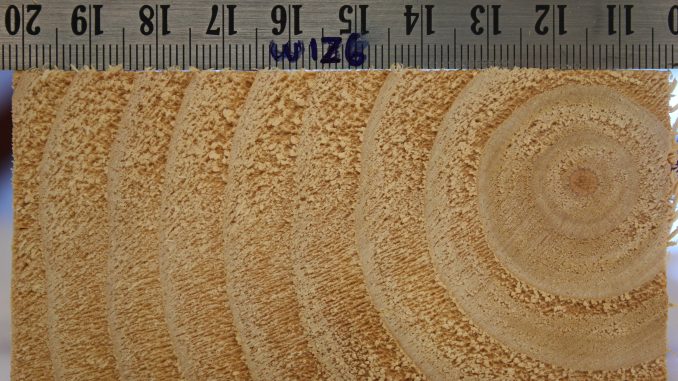
How big is a piece of timber?
If you are using a grading standard – such as the new European visual grading standard for tropical hardwoods EN 16737 – you will be directed to EN 336 for the topic of cross-section sizes and permissible deviations. We previously blogged about EN 336 here. But how do you actually measure those dimensions?
EN 336 refers you to EN 1309-1 for measuring cross-section dimensions. The scope of this standard tells you that it “specifies the methods of measuring dimensions of sawn timber.” and that “This standard applies to hardwood and softwood sawn timber, both square-edged and unedged.” but also “This standard does not apply to tropical timber.” [oops – that needs to be fixed, otherwise how do we know how to measure a piece of tropical timber?]
Here is what EN 1309-1 tells you:
For thickness (the smaller cross-section dimension)
– You need a measuring device graduated to an accuracy of at least 0.1 mm. [is that precision or accuracy? and that seems awfully precise if the timber is large]
For width (the larger cross-section dimension)
– You need a measuring device graduated to an accuracy of at least 1 mm. [hang on… 10 times less accurate than for the thickness? …although probably not going to bother having two different devices anyway. And what to do if the timber is square? Will have to look up the proper definitions of thickness and width now]
For length
– You need a measuring device graduated to an accuracy of at least 5 mm.
For this blog post we will only consider here the case that the timber is square-edged. For this you measure the thickness and width at least three places. Those places need to be free from defects. You measure near to each end (but at least 150 mm from it) and at some random point along the length. The smallest of these three measurements (each of thickness and width) is taken to be the measurement.
You state the thickness in mm to one decimal place and also the width in mm to one decimal place [even though you are allowed to measure that with a device with 1 mm graduations – interesting]
For length, you measure just once and express the result in metres to two decimal places, rounded down.
The measurement precision requirements are interesting because the test standard EN 408 only requires you to measure dimensions to 1% accuracy …which is actually a lower accuracy requirement for anything bigger than 10 mm!
The definition of width and thickness is actually in EN 844-6 [you need to buy a lot of standards to measure timber] and it says:
Thickness is the “Distance between the faces of a piece of sawn timber at the specified place of measurement” and
Width is the “Distance between the edges of a piece of sawn timber at the specified place of measurement”
Firstly – if we are being pedantic – this disagrees with how we are told to measure the timber because these are not about the place of measurement. Secondly, now we have to look up the definitions of face and edge. …we find those (eventually) in EN 844-3:
– Face is either the two wider faces of the cross-section, or any of the four faces if the timber is square.
– Edge is either of the two narrower faces of the cross-section.
OK – now we have an interesting new fact: Square timber has four faces and therefore four thicknesses (and no widths).
So, a loose traditional term like “two by four” would refer to the closest customary metric size of 47 mm by 100 mm. But if this was tolerance class 2 (machined on both sides) it would be a target size (because of the planing) of 44 mm by 97 mm. This target size is at 20% moisture content. When the piece is in service it is more likely to be about 12% moisture content. So, allowing for both moisture and tolerance class the piece can be as small as 41.8 mm by 93.3 mm. Which is actually about 1 & 5/8 inches by 3 & 5/8 inches.
If this all sounds slightly mind bending – spare a thought for the US where the topic of how big a “two by four” is, is now in the hands of lawyers. (fyi, a two by four in the US can be a fair bit smaller still)

Leave a Reply
You must be logged in to post a comment.